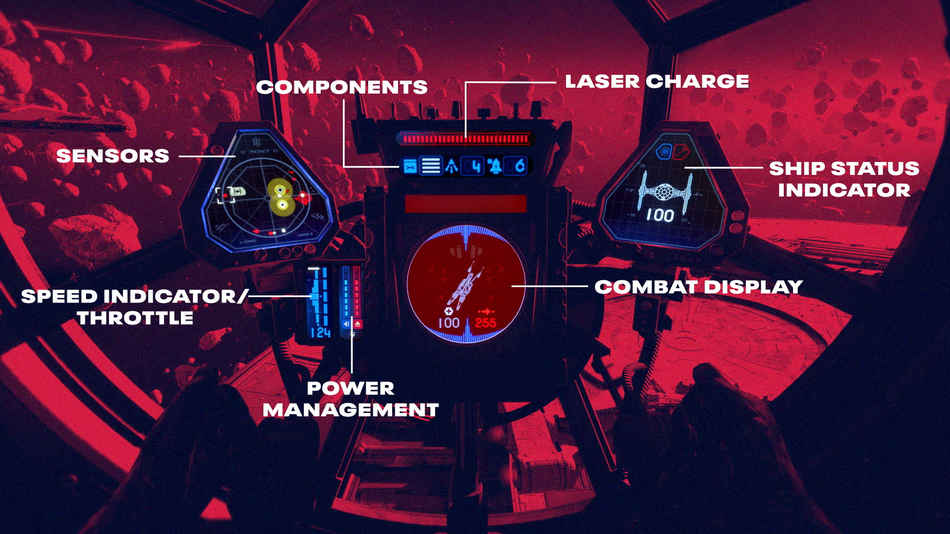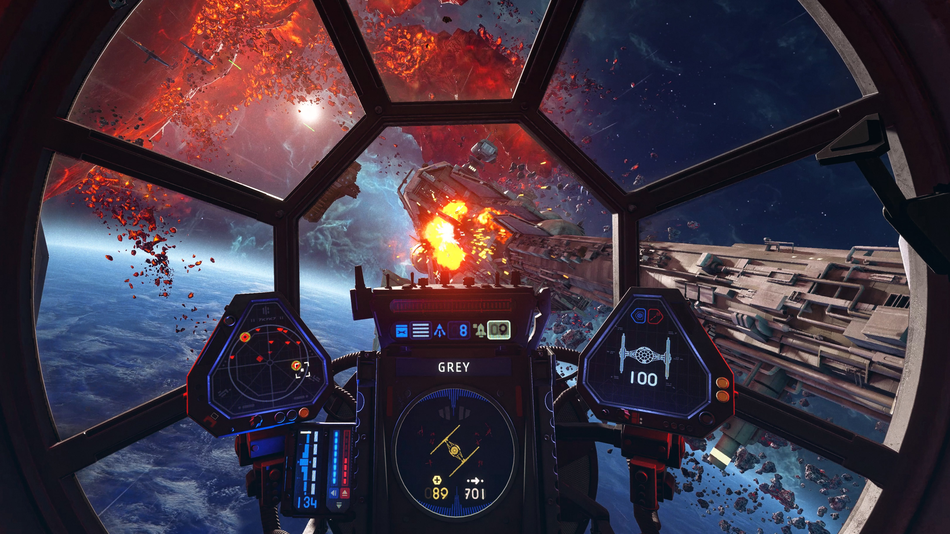Entertainment
The perfect 2020s spin on a ’90s fave
I sure did love Star Wars: X-Wing.
The 1993 space combat simulator set in a galaxy far, far away gave me the chance to live out all the Star Wars dogfighting fantasies my teenage brain could summon. And that’s exactly what EA’s Motive Studios set out to tap into with Star Wars: Squadrons. It’s a childhood dream, realized.
You should know right out the gate that this isn’t an arcade game. If your idea of a Star Wars flight sim is the Rogue Squadron series, or Battlefront II‘s “Starfighter Assault” mode, the focus in Squadrons on power management is going to feel overwhelming at first.
It’s not quite as complex as, say, Microsoft’s Flight Simulator. But you do have a lot of of moment-to-moment control over your ship’s performance, with the ability to funnel power toward weapons, engines, or (for the ships that have them) shields, and even redirect shields to focus them on protecting your ship’s fore or aft.
These are simple tweaks to make mid-battle, demanding nothing more than a button press. The skill, and the challenge, lies in knowing when to boost power to one system or another – and actually getting that timing right. You’ve still got to fly well and line up your shots, but those on their own won’t be enough for a lot of what Squadrons throws your way.
If you’re piloting an X-Wing in an attack run on an Imperial Star Destroyer, for example, you’ll probably want to pour power into your front-facing shields for added protection during the approach. How do you do it though? Approaching from the rear might be safer because there are fewer turbolasers, but fly to close to the engine exhaust and you’re going to get singed.
Star Wars: Squadrons is a childhood dream, realized.
The complexity in Squadrons‘ flight combat comes not just in understanding the controls but the rules as well. It’s about knowing the difference between lasers and ion cannons (the latter is best against shields). Or understanding that a big capital ship like that Star Destroyer has shields that you can slip underneath to attack ship systems directly, with the tradeoff being that you’re close enough to draw heavy fire from point defenses.
It’s also about using the right tools for the job, and your skillset. Each faction’s for fighters plays different and, similarly, serves a unique purpose in battle. An A-Wing is great for taking on Imperial T.I.E. Fighters, but the Y-Wing, a bomber, is going to be better-suited to take on bigger threats.
Every fighter can also be outfitted with different lasers, secondary weapons, armor, engines, and more. Rather than offering straight upgrades, these different parts typically boost one capability at the expense of another. So you might like the idea of a laser weapon with light autotargeting, but you’ll need to accept that it’s weaker than the “dumb” fire options.
It’s a lot! But that’s the fantasy, right? You’re stepping into a Star Wars dogfight, and just like Luke or Vader, you’re just as busy flipping switches and minding the ship as you are lining up enemies in your targeting reticle and blasting them out of the stars. The complexity brings depth, and that depth awfully satisfying once you get a handle on it.
Thankfully there’s a story mode, set not long after Return of the Jedi, which takes a gradual approach to teaching you how to be an ace pilot. The 14 missions spread across eight or so hours, introducing you to the ships of both the Empire and the New Republic, as well as the different kinds of ship loadouts that are possible and advanced techniques.

Those teachings play out against the backdrop of a story that sees the New Republic developing a secret project while a remnant faction of the Empire – led by Rae Sloane, a character from other Star Wars stories – tries to stop it. The missions run the gamut, from straight-up dogfights to defend-and-escort missions. There’s even a couple of “fly fast through this narrow space” sequences, a la Lando’s Death Star escape at the end of Jedi.
While the story on its own is a perfectly fine way to experience Squadrons, it also serves as a training ground for the game’s other big piece: online space combat. It starts with a basic dogfighting mode that pits two teams of five against one another in a battle for points and space superiority. Simple stuff, but a good place to get a handle on the faster, less forgiving feel of online play.
The marquee mode, however, is Fleet Battle. This one is an objective-based tug-of-war set in space. The two teams first vie for control in a basic dogfight while their larger support and capital ships hang back. Once a team scores enough kills to get the upper hand, they can press the attack and move to tackling the two support ships accompanying each faction’s capital ship. Take those out and it’s on to the big boy.
It’s not nearly that simple, though. Fleet Battles have an ebb and flow, so you can only press the attack on those larger ships for so long before enemy fighters regroup and threaten your own support and capital ships. The teams are still capped at five human players, but the battlefield is also filled with AI-controlled fighters and larger attack vessels.
Playing in VR is like having a theme park ride right at your desk.
If you’re familiar with Starfighter Assault, Squadrons‘ Fleet Battles feels smaller in scale and scope. But there’s so much more going on at the micro level of managing your ship, it feels like a necessary narrowing of focus. The push and pull that reveals itself in a match with five capable human players on each side making for a truly thrilling ride.
In a lot of ways, this idea of “narrowed focus” captures the Squadrons experience as a whole. There’s nothing at all after the story and two online modes. There are unlockable cosmetic items for your pilot (whom you rarely see) and ship. There’s a whole library of items to be unlocked using the in-game credits you earn in online modes. And Fleet Battles are ranked, with a season-based approach that promises to introduce new cosmetic loot to chase every eight weeks.
But that seemingly thin selection brings all the depth a Star Wars fan might want from an X-Wing or T.I.E. Fighter combat sim. The mouse/keyboard controls you can use on PC are actually the weakest option of all, with the mouse working as a sort of virtual flight stick that you move in relation to your centrally positioned targeting reticle. It’s just an unwieldy way to play, with the little “flight stick” cursor swimming around in your vision right where you’re lining up all your shots.
A standard gamepad, the option that most players will probably use, works well, though. For all of the granular power management there is, an Xbox or PlayStation has all the buttons you need to deal with that while still giving you the ability to fine-tune targeting options and juggle multiple weapons systems mid-flight. Just note that for PC players, Squadrons doesn’t support PlayStation’s DualShock 4 controller.
The best way to play, however, is with some kind of flight stick or HOTAS (“hands on throttle and stick”). It’s a pricey thing to add to your controller collection if you’re not a nerd for flight combat and flight simulator games, but it feels truly special to play in this way.

The same goes for virtual reality, which Star Wars: Squadrons supports on PlayStation and PC. I spent some time playing with a Saitek X52 Pro (there’s a newer Logitech version) and an Oculus Quest, and all I can say is wow. You’re sitting in the cockpit, craning your neck to follow an enemy ship as you whip the flight stick to and fro to line up your target.
It’s like having a theme park ride right at your desk. Getting the headset working with the PC version of Squadrons can be a bit of a chore. You’ll crash when you switch to VR if you’re running the game in fullscreen mode, for one. I also found the default view placed me a little too low in the cockpit, but that’s easily fixed by recalibrating your headset while you’re hunched down. Though there’s something sort of poetic about climbing into the cockpit of an X-Wing with the perspective of a little kid.
More importantly, these are the kinds of technical hiccups that come with the territory of PC gaming, as well as VR gaming. The tradeoff – stepping into your own, private Star Wars dogfight fantasy – is more than worth it. I’ve been having an absolute blast.
All that said, Squadrons isn’t necessarily a crowd-pleaser. Juggling the technical minutiae of attack fighter could get old quickly if you just want to fly and shoot. The campaign mode accounts for that with a gentler “story” difficulty setting, but online play – which is fully half the game here – offers no such luxury. Perhaps that’s why EA set the retail price at $40.
For me, Star Wars: Squadrons is hands down the very best space combat sim this series has ever seen. That’s not hyperbole; the closest rival here is more than 20 years old. Even if Motive never supports Squadrons past release, what we’re playing on day one is everything this X-Wing-loving nerd has ever wanted from a Star Wars game.
Star Wars: Squadrons will be available on Steam, Xbox One, PlayStation 4, and more starting Oct. 2.
-
Technology5 days ago
YouTube bans ‘harmful’ QAnon, Pizzagate, and other conspiracy theory content
-
Technology7 days ago
Triller follows TikTok in banning QAnon conspiracy content
-
Politics7 days ago
Win or lose, Trump supporters don’t want him on the ballot in 2024
-
Politics3 days ago
Rupert Murdoch predicts landslide Biden victory over Trump: Report
-
Entertainment4 days ago
13 essential movies about the fight for women’s equality
-
Entertainment4 days ago
Netflix’s ‘The Trial of the Chicago 7’: Separating fact from fiction
-
Politics3 days ago
Spies: Hunter Biden emails show Trump, Giuliani exploitable by Russia
-
Technology4 days ago
Unlock Netflix with Ivacy VPN (UK deal)



